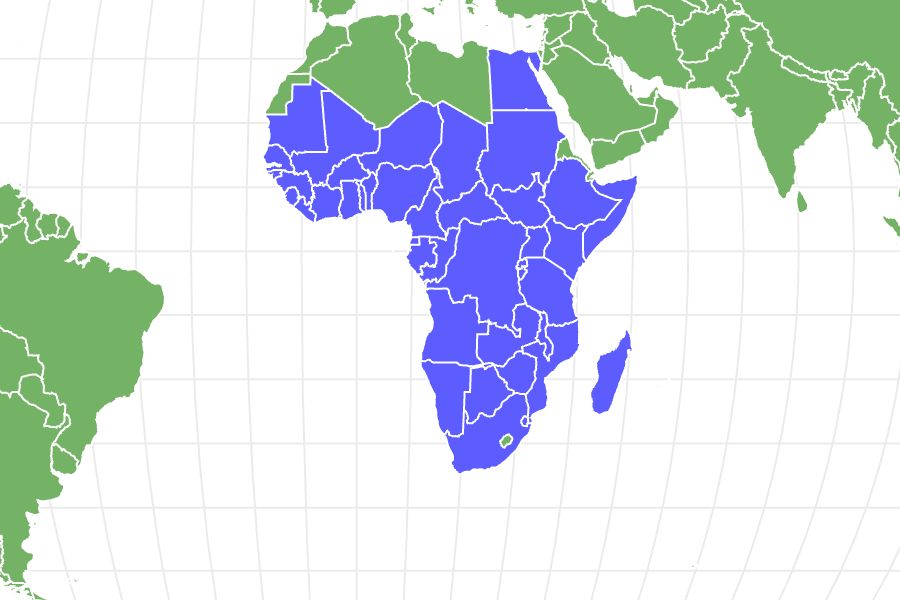Nile Crocodile
Crocodylus niloticus
Unlike other reptiles, the male Nile crocodile will stay with a female to guard their nest of eggs.
Advertisement
Nile Crocodile Scientific Classification
- Kingdom
- Animalia
- Phylum
- Chordata
- Class
- Reptilia
- Order
- Crocodilia
- Family
- Crocodylidae
- Genus
- Crocodylus
- Scientific Name
- Crocodylus niloticus
Read our Complete Guide to Classification of Animals.
Nile Crocodile Conservation Status
Nile Crocodile Facts
- Prey
- Fish, hippos, zebras, other crocodiles, birds
- Name Of Young
- Hatchling
- Group Behavior
- Solitary
- Fun Fact
- Unlike other reptiles, the male Nile crocodile will stay with a female to guard their nest of eggs.
- Estimated Population Size
- 50,000-70,000 mature adults
- Biggest Threat
- Poaching
- Most Distinctive Feature
- Large size
- Gestation Period
- 84-90 days
- Litter Size
- 25-80
- Habitat
- Mangrove swamps, rivers, freshwater marshes
- Predators
- Humans
- Diet
- Carnivore
- Type
- Reptile
- Common Name
- Nile Crocodile
- Number Of Species
- 1
- Location
- Africa
Nile Crocodile Physical Characteristics
- Color
- Dark Brown
- Olive
- Skin Type
- Scales
- Top Speed
- 22 mph
- Lifespan
- 45 years
- Weight
- 500-1,650 lbs
- Length
- 16-20 ft
- Age of Sexual Maturity
- Males: relates to their size; Females: 10 years old
- Age of Weaning
- Right after hatching
View all of the Nile Crocodile images!
A female Nile crocodile has a special pouch in her throat where she hides her young from predators.
An adult Nile crocodile can be as long as 20 feet! They are carnivores that can subdue and eat large mammals. This crocodile lives in various places throughout sub-Saharan Africa as well as in the Nile basin and western Madagascar. These reptiles communicate with one another by hissing and growling. They can live to be at least 45 years old in the wild.
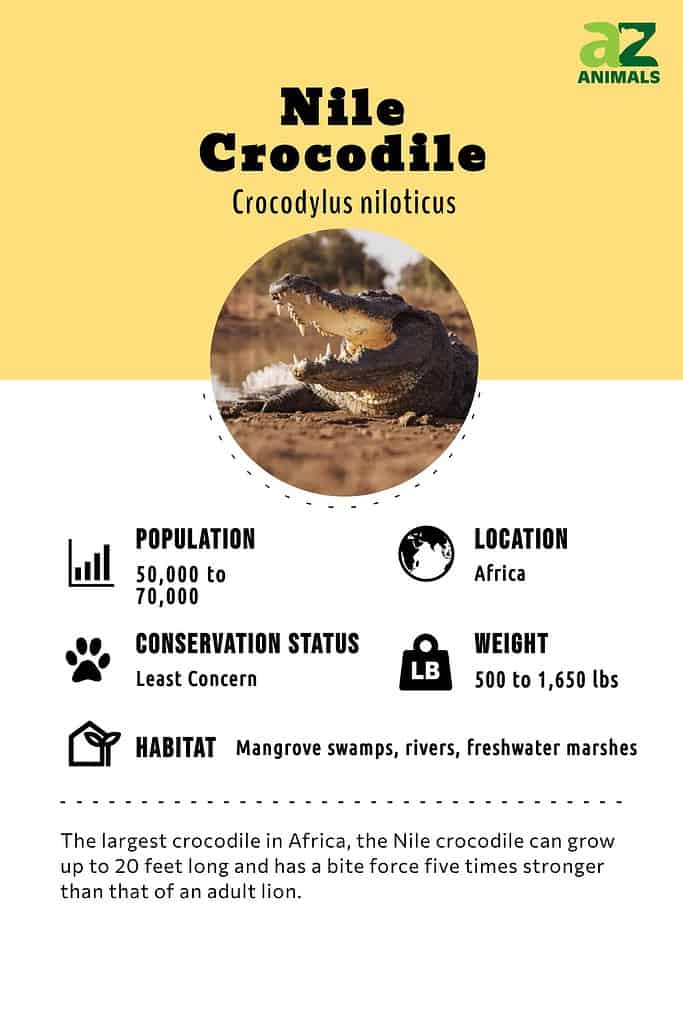
5 Incredible Nile Crocodile Facts!
- Both crocodile parents stay with their nest of eggs to protect their young from predators.
- It’s estimated that 200 people are killed each year by Nile crocodiles.
- These crocodiles can swim at a speed of 22 mph.
- The bite force of this crocodile is five times stronger than that of a lion.
- The Nile crocodile is the largest crocodile in Africa.
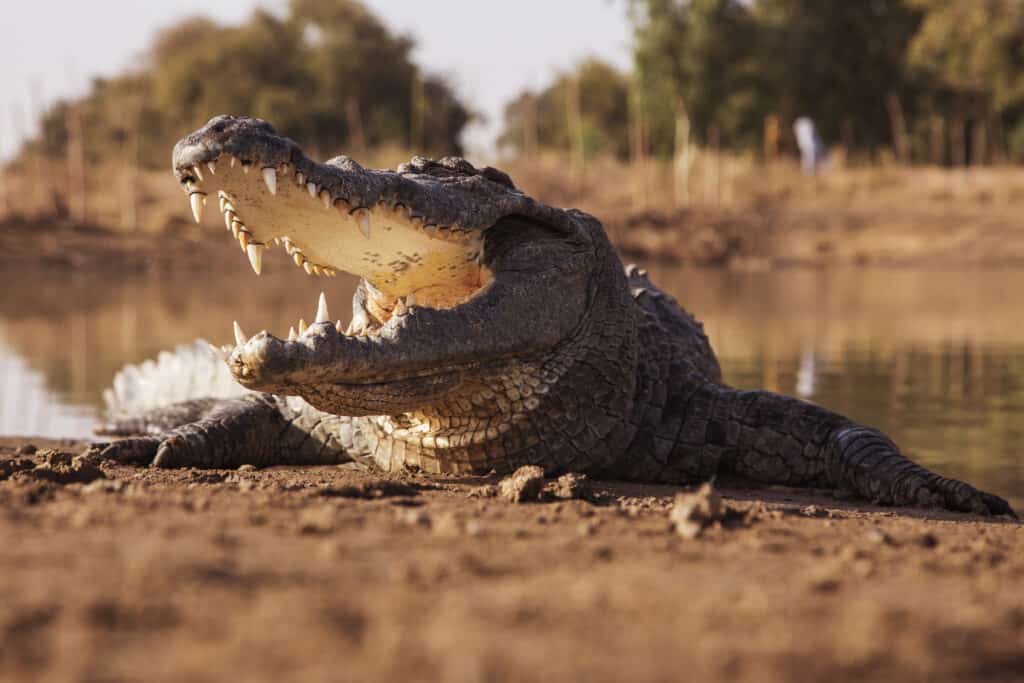
The Nile crocodile is the biggest crocodile species in Africa.
©StanislavBeloglazov/Shutterstock.com
Scientific Name
The scientific name of this crocodile is Crocodylus niloticus. Crocodylus comes from the Greek word meaning lizard and niloticus means from the Nile River. It belongs to the Crocodylidae family and the class Reptilia.
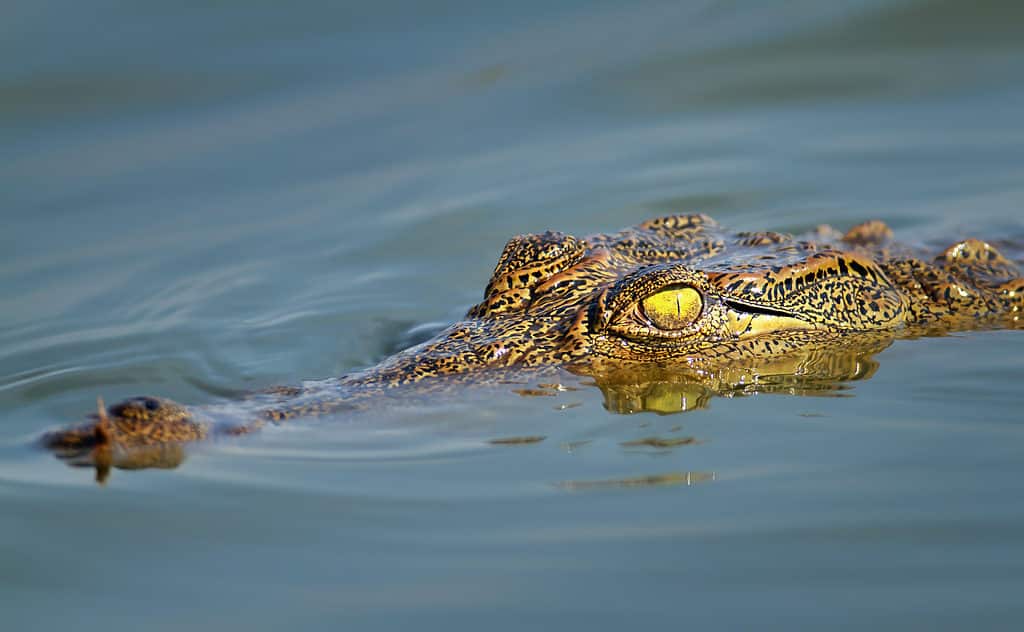
Its scientific name
Crocodylus niloticus
refers to the Nile River.
©Mari Swanepoel/Shutterstock.com
Types of Nile Crocodile
There are no subspecies of the Nile crocodile officially recognized, but up to seven subspecies have been proposed primarily due to differences in appearance and size. These include C. n. africanus (commonly referred to as the East African Nile crocodile), C. n. chamses (called the West African Nile crocodile), C. n. cowiei (the South African Nile crocodile), C. n. madagascariensis (known as the Malagasy or Madagascar Nile crocodile), C. n. niloticus (as the Ethiopian Nile crocodile this would become the nominate subspecies if recognized), and C. n. pauciscutatus (named the Kenyan Nile crocodile). However, none of these have been formally confirmed as subspecies.
In 2011, researchers from Fordham University in New York discovered that crocodiles previously considered Nile crocodiles were in fact from another, distantly related species. This species was the West African crocodile (Crocodylus suchus), also known as the desert crocodile or sacred crocodile.
The scientists conducted DNA analysis of samples and found that the West African crocodile matched the museum-sourced 2,000-year-old mummified crocodile samples, indicating that it was present in ancient Egyptian times. The West African crocodile is smaller and more docile than the Nile crocodile, and its population is declining due to habitat loss and being hunted for its meat and skin.
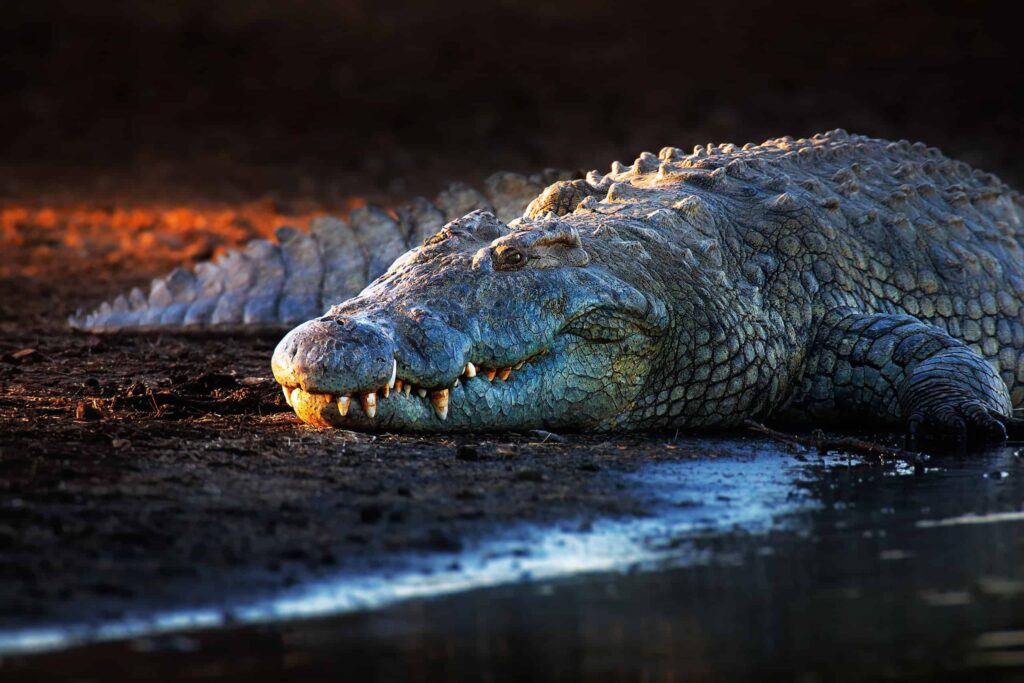
Several subspecies of the Nile crocodile have been proposed but none formally recognized.
©Johan Swanepoel/Shutterstock.com
Evolution and Origins
While many refer to crocodiles as “living fossils” that have not evolved for millions of years, the genetic evidence collected by the Fordham University researchers shows that Nile crocodiles are adaptable like other modern species.
They also discovered that the Nile crocodile’s closest relations are four crocodiles species of the Americas: C. acutus (the American), C. rhombifer (Cuban), C. moreletii (Morelet’s), and C. intermedius (Orinoco).
The researchers believe it was only possibly within the past 3 million years that the genus Crocodylus migrated out of Africa, with the Nile crocodile making its way to the Western Hemisphere by rafting or swimming.
Fossil evidence dating from the Plio-Pleistocene era 5.3 million years ago to 11,700 years ago suggests two extinct Crocodylus species from Africa, C. anthropophagus and C. thorbjarnarsoni, were closely related to the Nile crocodile.

Many refer to crocodiles as “living fossils” but recent research shows this is a misnomer.
©David Havel/Shutterstock.com
Appearance
A Nile crocodile looks a lot like a giant lizard. Its body is covered in tough scales that are grayish-brown or olive in color. In addition, this reptile has crossbands of dark scales covering its powerful tail. The Nile crocodile has four short legs along with clawed feet. Their back feet are webbed making them excellent swimmers. They have green eyes with vertical pupils specially designed to help them see in their watery environment at night.
One of the most fearsome things about the Nile crocodile is its size. They grow to an average length of 16 feet but can measure as long as 20 feet. They weigh from 500 pounds to 1,650 pounds. As a comparison, from its nose to the tip of its tail a 20-foot crocodile is the same length as three-quarters of a London bus. A 1,650-pound Nile crocodile is equal in weight to half of an average car. No wonder these reptiles are so confident when attacking large prey!
A Nile crocodile named Gustave is the largest one on record at more than 20 feet long.
The dark scales of these crocodiles help them to blend into their environment. However, adult Nile crocodiles have no predators except humans. Their ability to blend into their environment helps them when stalking and attacking their prey.
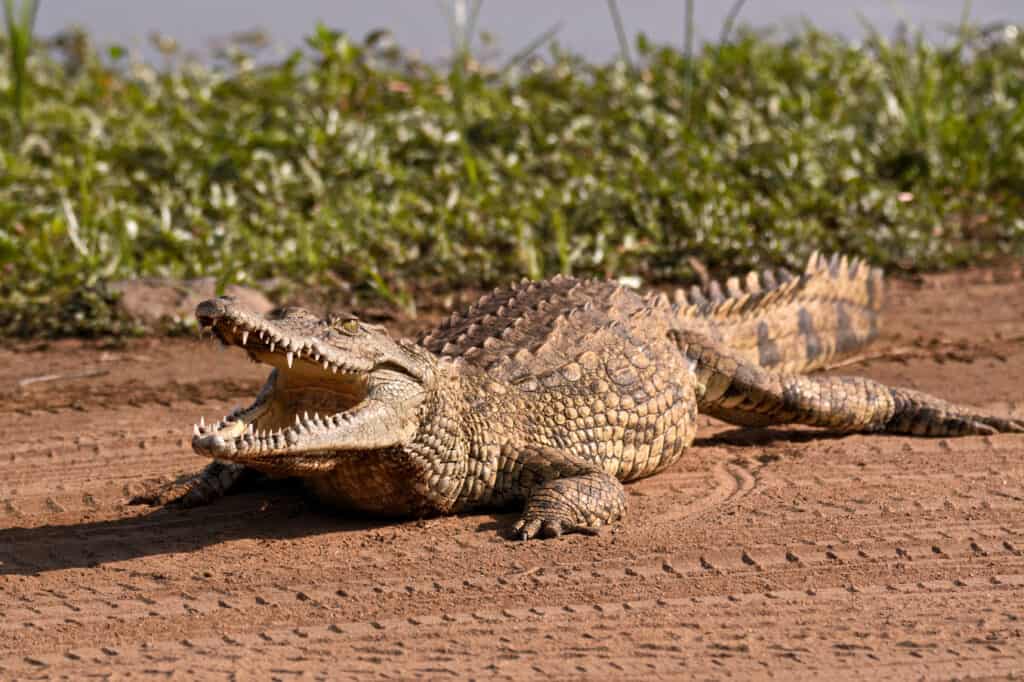
On average, a Nile crocodile can grow to 16 feet and weigh 500-1,650 pounds.
©iStock.com/Robby_Holmwood
Nile Crocodile vs Saltwater Crocodile
When comparing the Nile crocodile to the saltwater crocodile the first thing to note is the saltwater crocodile is the larger of the two. In fact, the saltwater crocodile holds the title of the biggest crocodile in the world. The Nile crocodile is the second-largest.
Another difference between these two crocodiles is the Nile crocodile lives in freshwater habitats in Africa. The saltwater crocodile lives in southeast Asia, northern Australia, and eastern India.
Not surprisingly, these two gigantic crocodiles have some things in common as well. For one, they both have a diet of fish along with birds and large mammals. Both types can live 45-plus years in the wild and even longer in captivity. Also, both crocodiles have a tremendously strong bite force.

The saltwater crocodile is larger than the Nile crocodile.
©Danny Ye/Shutterstock.com
Behavior
Nile crocodiles are known for their ability to burrow. They use their clawed feet to burrow so they can go underground if the weather becomes too cold or hot for them to survive. Some of these burrows are 12 feet deep while others are close to 40 feet deep. These reptiles retreat into their burrow and go into a state similar to hibernation called aestivation. During aestivation, a crocodile’s heart beats just twice a minute.
This crocodile uses its teeth and tremendous bite force to grab onto its prey. Its bite force can be as strong as 5,000 Ibf. Lbf refers to the weight of the crocodile and the force of its bite. Think of it this way: The strength of a Nile crocodile’s bite is five times more than the bite force of an adult lion.
One of the most interesting facts about this reptile is it can be both solitary and social. They may hunt alone or work with other Nile crocodiles to trap and eat a school of fish. Also, Nile crocodile parents work together to protect their eggs from predators. These crocodiles can sometimes coexist in the same territory.
A gathering of four or five crocodiles lying in the sun on shore is called a bask. Alternatively, a group of crocodiles swimming together is called a float.
Due to their size, these crocodiles are aggressive and have no hesitation in attacking large mammals and humans near the shoreline.

A Nile crocodile’s bite is five times stronger than that of an adult lion.
©iTENG/Shutterstock.com
Habitat
These reptiles live in sub-Saharan Africa, the Nile basin, and western Madagascar. Specifically, they live in freshwater swamps, mangrove swamps, rivers, estuaries, and large lakes.
These cold-blooded reptiles live in a moderate climate and rely on the sun’s rays to keep them warm. They spend most of the day basking in the sun without moving. If a crocodile starts to get too hot in the sun, it opens its mouth to let excess heat pour out and evaporate. In the evening, they go back into the water to hunt and cool off. When the weather gets too cold for them to survive, these reptiles dig a burrow and go into aestivation underground.
Some Nile crocodiles migrate to different areas to find a larger food supply or to find a suitable place to make a nest.
Interestingly, there have been a few of these crocodiles seen and captured in the Everglades in Florida. It seems very strange that crocodiles from Africa should show up in south Florida! Biologists have some theories as to how these crocodiles arrived in the Everglades. The main theory is reptile collectors illegally sold hatchlings to people in the United States. Before long, the crocodiles got too big for their owners to care for. Consequently, they were released into the Florida Everglades.
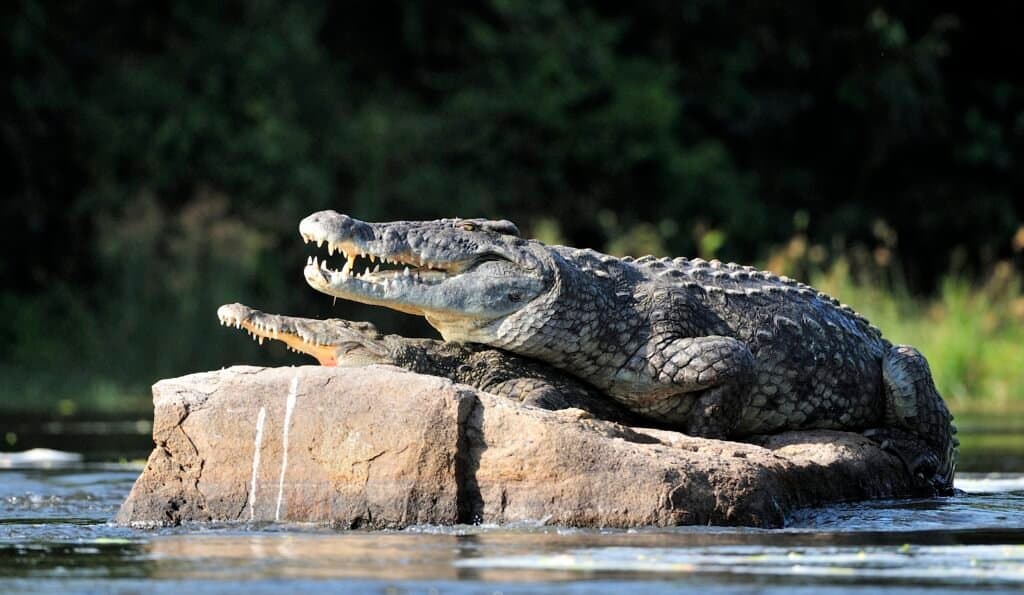
Nile crocodiles spend most of their day basking in the sun to keep warm.
©iStock.com/USO
Diet
Nile crocodiles are carnivores. They usually hunt in the evening and at night. This crocodile can consume a supply of food equal to half its body weight. So, a 1,000-pound Nile crocodile could eat a 500-pound zebra in a single meal.
Being the biggest crocodile in Africa means this reptile has a lot of prey to choose from. Nile crocodiles eat a variety of fish. They are also known for attacking large mammals such as zebras, buffalo, antelope, and even small hippos.
A Nile crocodile is able to remain very still watching a mammal such as a zebra or an antelope taking a drink from a river or lake. Though these crocodiles are large, they are also very fast. They dart up out of the water and clamp down on their prey using their tremendous bite force to hold and subdue it.
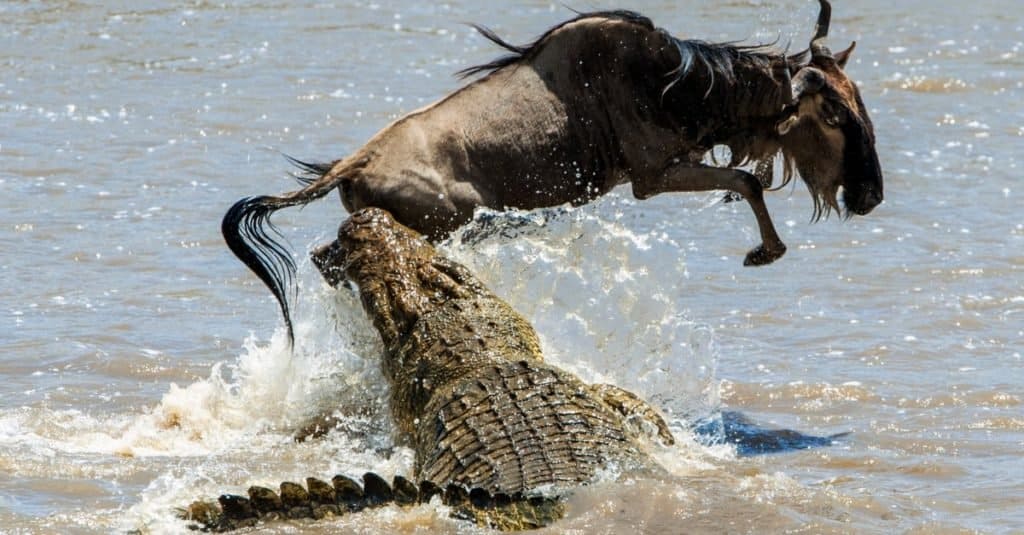
The Nile crocodile can consume prey that is half its body weight.
©Sergey Uryadnikov/Shutterstock.com
Predators and Threats
Nile crocodiles don’t have any natural predators. Young Nile crocodiles are targeted by many predators, including Nile monitor lizards, African fish eagles, snakes, and honey badgers.
The main threat to these crocodiles is humans, causing habitat loss due to land development. In addition, the crocs sometimes become entangled in commercial fishing nets and die. Poaching is another threat to these crocodiles, who are hunted for their meat and eggs.
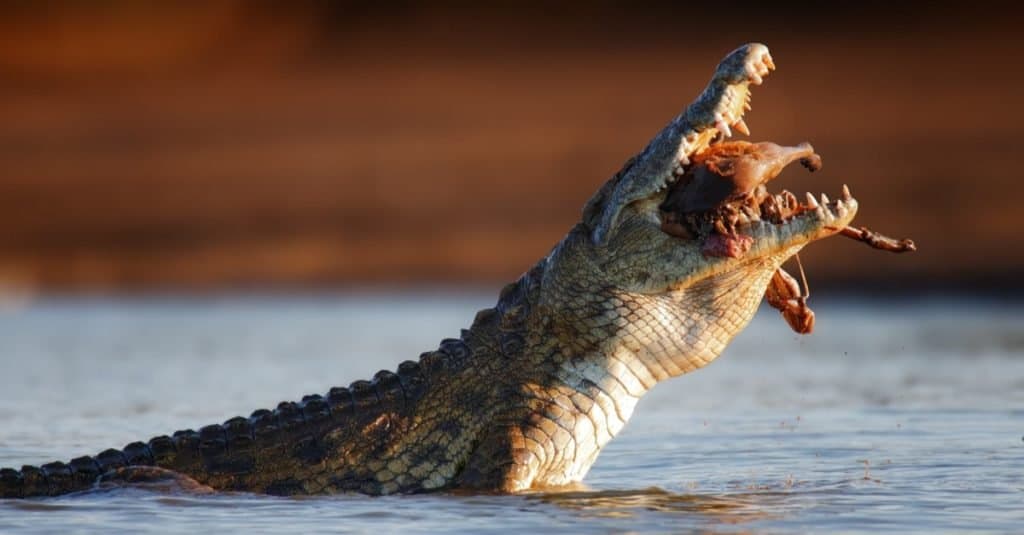
Nile crocodiles are apex predators so do not have any natural enemies in their habitats.
©Mari Swanepoel/Shutterstock.com
Reproduction, Babies, and Lifespan
The mating period of this crocodile happens during the dry season. Male crocodiles try to attract females by splashing with their snouts, spraying water, and making growling sounds. Once the strongest male drives all the others away, the female and male mate. Most male crocodiles mate with many females during the breeding season. But the male Nile crocodile stays with a female to guard their nest of eggs. That’s one of the most unusual facts about this crocodile. As a general rule, most reptiles lay their eggs and leave them.
The female digs a burrow about 20 inches deep to serve as a nest for her eggs. She lays 25 to 80 eggs in the burrow and pushes sand over them. The eggs are about 3 inches long and weigh a few ounces. The incubation period is around 90 days.
Baby crocodiles are called hatchlings. If a hatchling is having trouble breaking out of its egg, the female crocodile may put it in her mouth and roll it around to help with the hatching process. Once the eggs hatch, the female takes the hatchlings into her mouth and carries them to the water. Hatchlings can see, walk, and swim from birth. They stay with their mother for the first two months of life. During that time, the hatchlings learn to capture insects and small fish. Though the mother crocodile gives them protection, hatchlings are vulnerable to many predators.
The typical prey of these crocodiles increases in size as the crocodile grows. So, by the time this reptile reaches adulthood, it’s eating large mammals.
These crocodiles can live 45 years or more in the wild. These reptiles live even longer in captivity. Henry, a Nile crocodile living in South Africa, is believed to be the oldest at 122 years old in 2022!
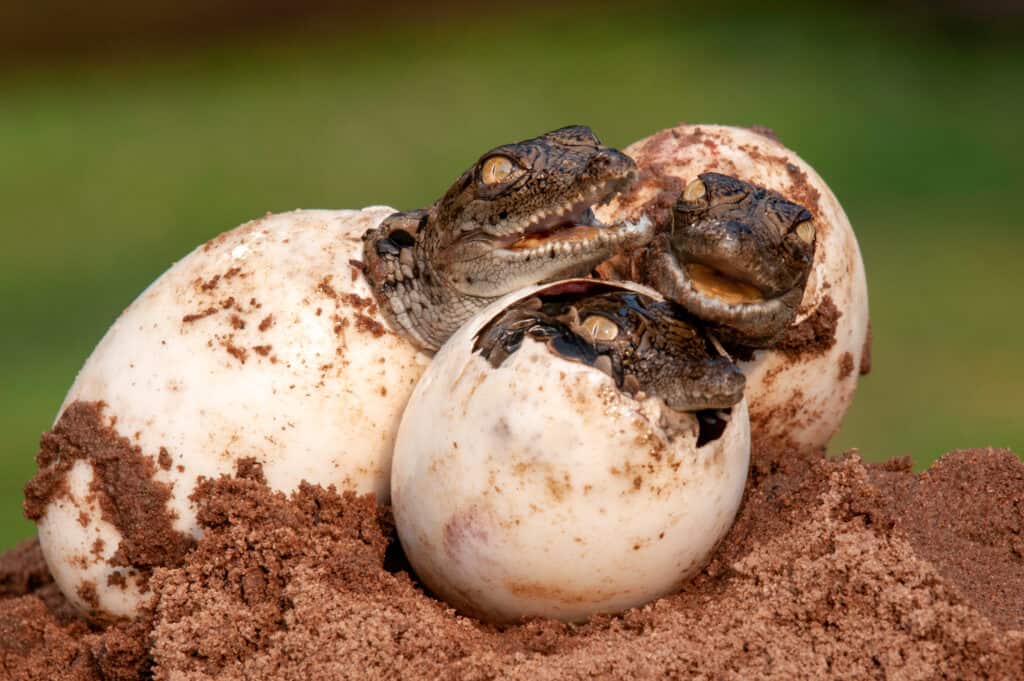
Baby crocodiles are called hatchlings and can see, walk, and swim from birth.
©Catchlight Lens/Shutterstock.com
Population and Conservation
Scientists estimate the population of these crocodiles at 50,000 to 70,000 mature individuals.
The International Union for Conservation of Nature (IUCN) lists the Nile crocodile’s conservation status as Least Concern with a stable population.
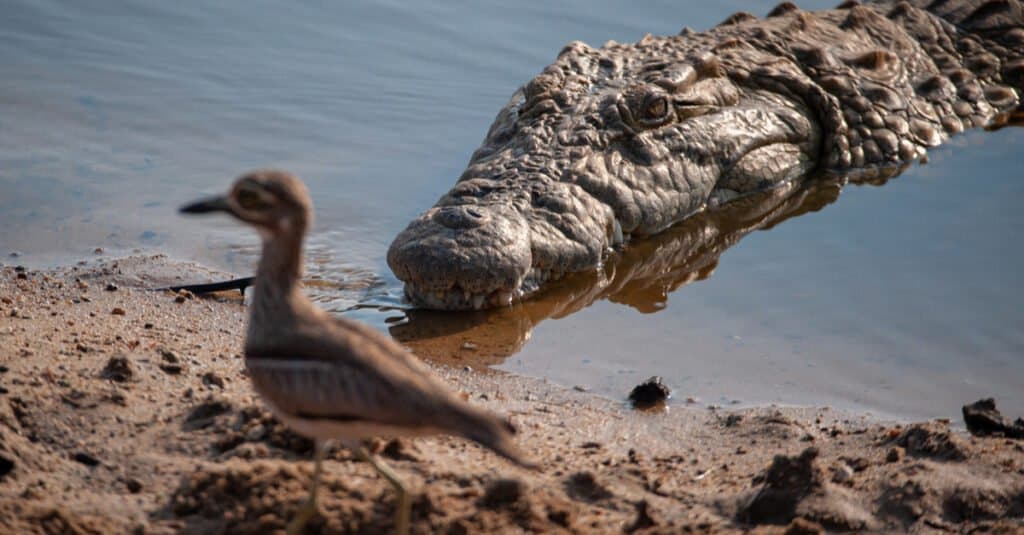
The Nile crocodile is listed as Least Concern by the IUCN.
©Rudi Hulshof/Shutterstock.com
Nile Crocodile FAQs (Frequently Asked Questions)
Are Nile crocodiles carnivores, herbivores, or omnivores?
Nile crocodiles are carnivores. They eat fish as well as zebra, buffalo, birds, wildebeest, turtles and more.
How dangerous is the Nile crocodile?
The Nile crocodile is very dangerous. Not only is it the biggest crocodile in Africa, it’s also a powerful, fast animal. It has a bite force that’s five times more powerful than a lion.
Do Nile crocodiles eat humans?
Yes, these powerful crocodiles have the ability to eat humans. In fact, an estimated 200 people are killed each year by Nile crocodiles.
Can a Nile crocodile kill a lion?
Nile crocodiles do have the potential to kill a lion. If a crocodile severely injures a lion and other crocodiles are around to subdue it, then a lion could be killed by a Nile croc.
What eats the Nile crocodile?
A human who hunts and kills an adult Nile crocodile may do so in order to eat its meat.
Nile crocodile hatchlings have a long list of predators. They are eaten by Nile monitor lizards, African fish eagles and snakes among other animals.
How big is a Nile crocodile?
An adult Nile crocodile is usually around 16 feet long, but they can grow to be 20 feet. These reptiles can weigh from 500 to 1,650 pounds.
What are the differences between the Nile crocodile and the saltwater crocodile?
The most significant differences between a Nile crocodile and a saltwater crocodile are their size, color, and preferred habitats. Saltwater crocodiles are larger than Nile crocodiles on average, weighing between 400 and 1,150 pounds while the Nile crocodile averages between 500 and 910 pounds.
What are the differences between a Nile crocodile and an alligator?
The biggest differences between a Nile crocodile and an alligator include their size, morphology, and habitats.
What are the differences between an American crocodile and a Nile crocodile?
The greatest differences between an American crocodile and a Nile crocodile are their size, colors, and location. The American crocodile grows to an average length of between 9 and 13 feet and weighs up to 800 pounds, and the Nile crocodile averages 9 to 15 feet in length and weighs between 500 and 910 pounds on average.
Thank you for reading! Have some feedback for us? Contact the AZ Animals editorial team.
Sources
- Wikipedia, Available here: https://en.wikipedia.org/wiki/Nile_crocodile
- Crocodile Specialist Group, Available here: http://www.iucncsg.org/pages/Temperature-Regulation.html
- Sea World Parks & Entertainment, Available here: https://seaworld.org/animals/facts/reptiles/nile-crocodile/
- Ocean Leadership, Available here: https://oceanleadership.org/nile-crocodiles-identified-south-florida-scientists-say/

